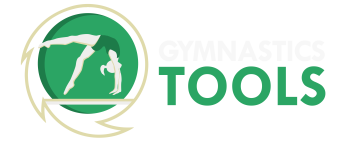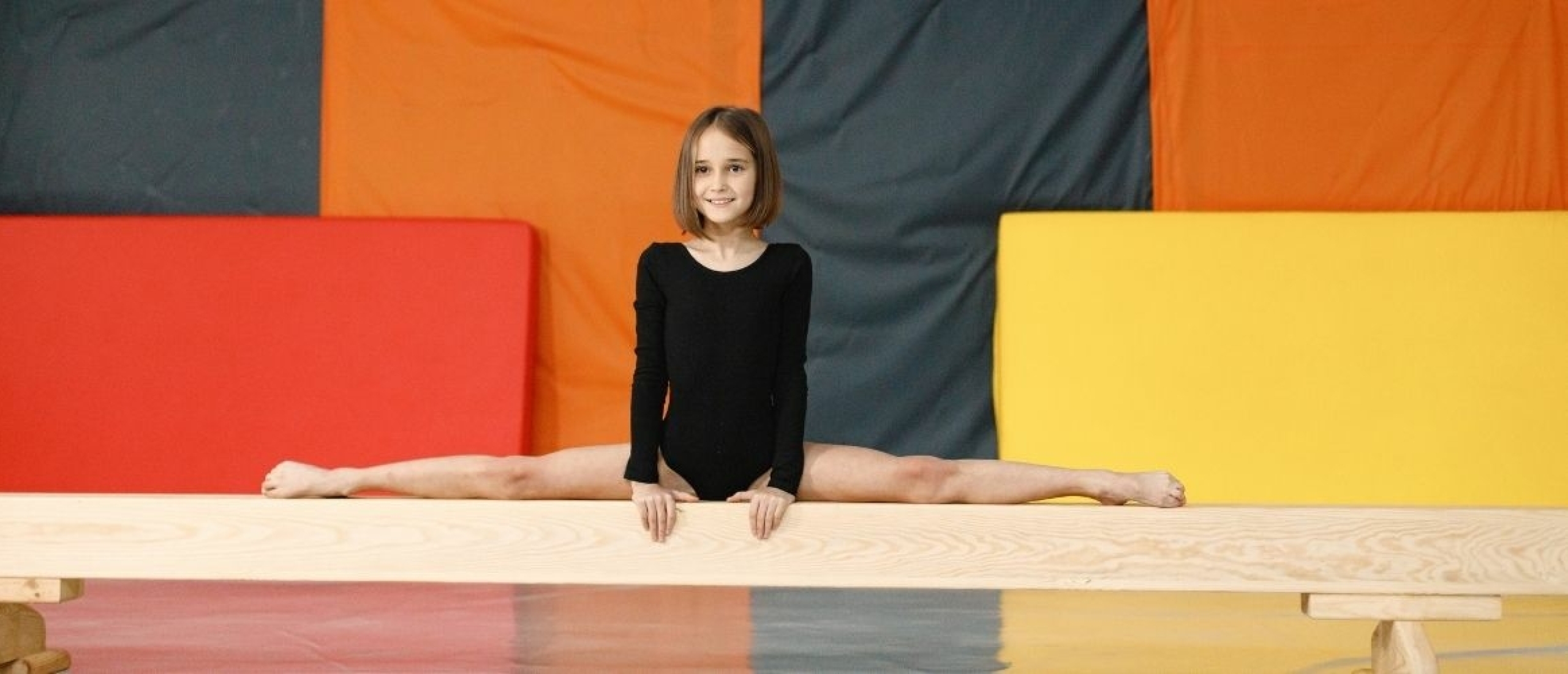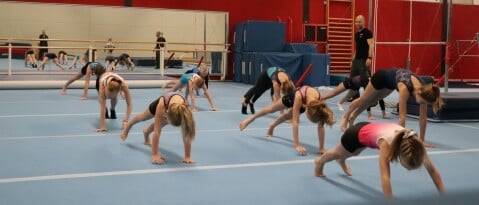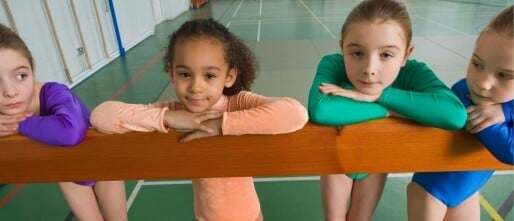Form tension is extremely important in gymnastics, so as a gymnastics coach you are naturally constantly hammering away at it. The form tension has to get better and better with the beginning gymnasts. How do you get that done? This is a big challenge for many gymnastics coaches. In this blog I will give you some tips and examples of exercises you can use to improve form tension.
Repeating a lot = better form tension?
Coaches have the idea that you have to repeat a lot, but the question is whether repeating a lot really improves form. The moment you start repeating a lot, it is a very traditional form of coaching. And that is very susceptible to 'choking under pressure'. This means that the moment you have a competition, for example, you can no longer perform the exercises properly. It may be that someone can do a handstand perfectly during gymnastics training. But the moment that person performs a handstand in a competition, in a new hall with different light and a different apparatus, he or she will no longer be able to do it as well as before. This is called the 'choking under pressure' principle; if you repeat a lot, it's good for one specific situation.
Gymnastics in different situations
If you repeat a lot in your own gymnasium in the same way, that situation will improve. Then this is not necessarily very suitable if you also want to do a competition. Your goal is ultimately for gymnasts to be able to perform everything perfectly in different situations. And at different competitions. That is why we are switching more to differential training. This ensures that the gymnasts can perform the gymnastics elements in a good way in different situations and in different applications. And eventually they don't have to think about it anymore. Therefore, repeating it over and over again is not always better for the gymnasts. In general, it is also more susceptible to injury. I would therefore definitely advise you to offer it more differentially. Fortunately, this is being done more and more within the gymnastics sport; a good shift!
From unconsciously incompetent to unconsciously competent
When teaching a better form tension, you go from unconscious incompetence to unconscious competence of an athlete. Let's take a gymnast as an example. She is competing on the bridge and performs a kurbet movement on the high bar. This is a situation in which she is partly thinking about the movement and partly not. There are, of course, many impulses at a competition; a jury is watching, parents are watching, there is a trainer present and many other people are watching. So of course it is a completely different situation than in the gym or in the competition hall.
Above is an example of a model in which a gymnast generally starts from unconscious incompetence. She doesn't realise that she hasn't mastered the form tension properly. In the end we make her consciously incompetent, so she knows when the legs are tense or not. Then she knows in the movement when this is the case. Then you want her to become consciously competent; she knows what to do to make sure she can tense her legs. Or in the case of the bridge gymnast; that she knows that she has to maintain a convex position when she hangs. And at what point she should hold the concave position. She also knows that she has to keep her legs together. And that they should stay together at the moment she changes from concave to convex.
The ultimate goal is that she becomes unconsciously competent. She does the exercise but she doesn't have to think about it. She can do it perfectly without thinking about it. This is the cycle you go through to ensure that she eventually learns perfect gymnastics automatically.
Shape tension exercises
What exercises can you use to ensure that you learn form tension?
In this example, we have a bowl where it is difficult for many gymnasts to keep their back on the ground, so they learn to tilt their pelvis.
In this example, the gymnast pushes her back on a Frisbee so that she learns to push her back down. She also learns at the same time to keep her chin to her chest and her feet together. In this case, the materials ensure that the posture is adjusted. This is an example of implicit learning; the exercise challenges you to do what you want to do.
As coaches, we often have the tendency to say "Try to push your back to the ground" or "Make your back round", but in general a method of differential training (e.g. implicit learning) often works better and stronger. So it also sticks better.
In this example, you see a game form where the athletes can throw the small bowl they have learned to push their back into the Frisbee. This is an application of the previous exercises, from which they have to do it automatically. Chances are that in the end they don't think about what they have to do exactly, but they do adopt a good posture.
If they like these exercises, of course, you have achieved your goal and the road to unconscious competence is also accomplished.
Other exercises
Getting the gymnast to look at and feel her own movement:
In the example below you can see an application with small material, and with a swing added. In this way, you don't have to point out to the gymnasts that the legs and the knees have to stay together. Here, the gymnast feels herself if she releases the Frisbee or not, so she gets feedback from the exercise.
Below you can see the application swinging towards the road, before eventually becoming the giant. When they go for the giant, of course in the end they have to unconsciously maintain that convex posture. You work towards that in the end.
Sole turning
When turning the sole, of course, you want the feet to stay on the stick, so the legs must keep pressure on the stick and the hands and legs must stay on the stick.
This example shows an exercise in which one gymnast tries to take the elastic from the other. In this way, the other gymnast must also keep pressure on the elastic. This is a simplified exercise because the zolendraai is of course often done upside down. This makes it a lot easier to teach the gymnasts how to put pressure on the elastic.
In this case, also upside down. This is again a bit more difficult than the previous situation. But it is still a game form and that ensures that it succeeds unconsciously.
In this example you see an application to the stick itself. This is different from the rubber band, but it is a different kind of exercise. eventually, you move on to the sole twist itself. Then they have to be able to keep the pressure on the stick itself.
So you see you have a lot of different applications to work towards.
The road to unconscious competence
This is an exercise with head rolls in which the gymnast has to keep her chin on her chest. The aim of this game was to bring as much stuff as possible. They can bring something by holding something under their chin or between their knees or between their ankles. For them it is a game, so they like to do it and they are unconsciously doing it. My goal as a coach is of course that they do the things I think are important automatically. But of course this makes it a lot more fun than having them do a head roll and saying "Keep your legs together" or "Push your chin up to your chest" every time. This is generally a more effective way anyway.
Additional tips
- Choose variation. This ensures that gymnasts are able to perform things subconsciously and therefore there is less external influence. This is ultimately very useful for competitions.
- Use games and challenges. That way you make it fun for gymnasts. Gymnasts often don't like to train with form tension, but if there is a game form or a challenge they often really like it and they train much harder for it.
- Important: If a gymnast is not able to tighten during practice/competition, think carefully for yourself as a coach whose fault it is. Is it the fault of the gymnast that she is not focused enough or did you as a coach maybe not pay enough attention to it or did you only teach the form tension during gymnastics training in the same way? So it's good to first look at yourself as a coach and then see how you can solve it.
More tips?
I hope the tips and examples I have given have helped you. If you need more tips, you can find several downloads on our website.
If you are interested in the flexibility and form tension sections in particular, we have a flexibility and form tension coach bundle for you.
If you are interested in our membership, you will get access to everything we have. So access to the bundle as well as all the other tools and training tools and lesson preparations.
Finally, you might be interested in this online continuing education course; Giving differential training. This is a course that teaches you how to offer these types of exercises in a fun and different way, so that you can eventually learn to move away from traditional training by offering differential training and enrich your lessons.
I wish you good luck with your training!






